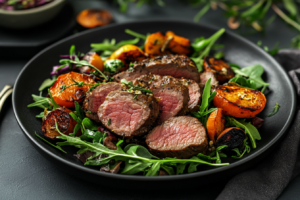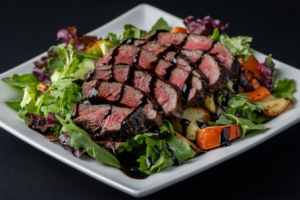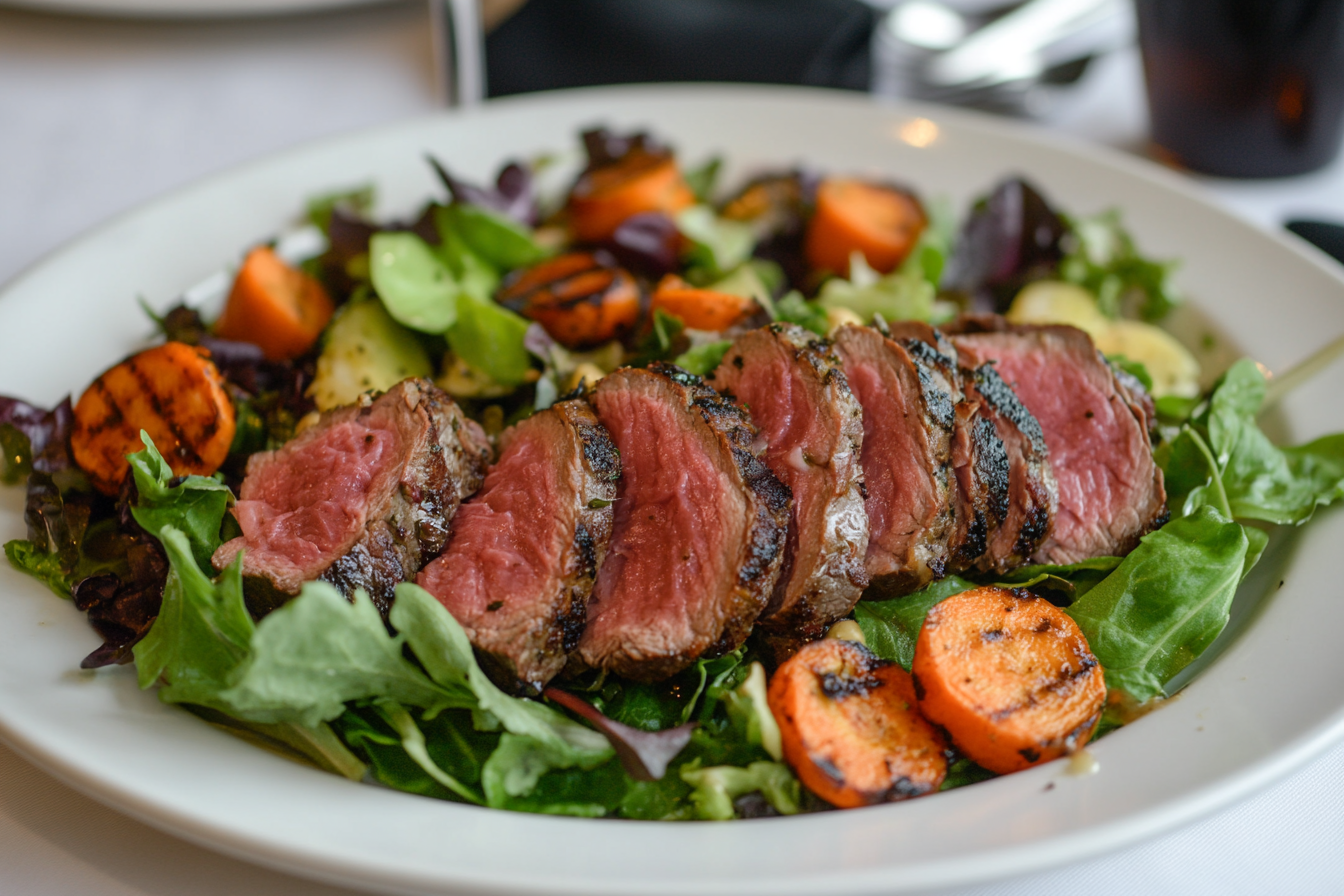What is Beef Tenderloin?
Before diving into the many leftover beef tenderloin recipes, it’s essential to understand what beef tenderloin actually is. Whether you’re a seasoned chef or someone who’s just starting to get comfortable in the kitchen, knowing the cut of beef you’re working with makes all the difference. Beef tenderloin is renowned for its tender, juicy texture and rich flavor, making it one of the most sought-after cuts of beef. But what exactly is it, and why is it perfect for leftovers? Let’s take a closer look.
What is Beef Tenderloin?
At its core, beef tenderloin is a boneless cut from the cow’s lower back, specifically from the short loin area. This is the part of the cow that doesn’t do much work, which is why the muscle is incredibly tender. Unlike tougher cuts like flank steak, beef tenderloin has a soft, melt-in-your-mouth texture, which makes it perfect for grilling, roasting, or pan-searing. The key to its tenderness comes from the fact that it is not a weight-bearing muscle, unlike other cuts.
One of the best parts about beef tenderloin is that it is incredibly versatile. You can cook it as a whole roast or cut it into individual steaks (such as filet mignon). However, after indulging in a mouthwatering beef tenderloin dinner, there’s a chance you’ll end up with some leftovers. Fortunately, these leftover beef tenderloin pieces are just as delicious when repurposed into new meals.
How to Cook Beef Tenderloin
Cooking beef tenderloin to perfection might seem like a daunting task, but it’s actually quite simple once you understand the basic methods. Whether you’re making a whole roast or cooking individual steaks, the key is to avoid overcooking the beef. The goal is to achieve a perfectly cooked, juicy piece of meat that retains its flavor and texture.
- Oven Roasting: The classic method for cooking a beef tenderloin roast is in the oven. Season generously with salt, pepper, and any other spices you prefer, then roast at 425°F (220°C) for about 20 minutes per pound for medium-rare. This creates a beautiful crust on the outside while keeping the inside tender and juicy.
- Grilling: If you’re grilling individual tenderloin steaks, preheat your grill to medium-high heat. Grill the steaks for 3-4 minutes per side, depending on the thickness, for a perfect medium-rare finish.
- Pan-Searing: For smaller cuts like filets, pan-searing is a fantastic option. Heat a little oil in a cast-iron skillet over medium-high heat, and sear the beef for 3-5 minutes on each side. You can finish cooking the steak in the oven if needed.
While the beef tenderloin itself is already a showstopper, the beauty of leftovers is that you get to enjoy the juicy, flavorful beef again in new, exciting dishes.
Why Leftover Beef Tenderloin is a Great Ingredient
Leftover beef tenderloin isn’t just a way to save food; it’s a flavor-packed ingredient that can elevate your meals in a variety of ways. Whether you’re repurposing last night’s dinner or preparing for a busy week ahead, using leftovers can bring big rewards. Let’s explore why leftover beef tenderloin is so beneficial, both in flavor and in practicality.
Flavor Preservation and Versatility
One of the best things about beef tenderloin leftovers is that the rich flavor tends to last, even after being stored. When properly reheated, the tenderloin retains its delicious taste and juicy texture, making it perfect for a variety of recipes. Tender and flavorful, leftover beef tenderloin can be sliced thin for sandwiches, diced for tacos, or even shredded for stews and stir-fries. The beauty lies in its versatility — you can incorporate it into anything from a quick salad to a hearty pasta dish.
The natural juiciness of beef tenderloin, especially if you’ve cooked it right, means that even when reheated, the meat won’t dry out. Instead, it keeps its delicious taste and texture, providing you with endless possibilities. Whether you want a light dish or a filling one, leftover beef tenderloin is up to the task.
Time-Saving and Cost-Effective
Another significant advantage of using leftover beef tenderloin is the time and money it saves. Cooking beef tenderloin takes time and effort, but by repurposing your leftovers, you can create new meals in a fraction of the time. No need to spend hours in the kitchen. Instead, just reheat the beef and add a few fresh ingredients to create a whole new dish.
Beyond the convenience, using leftover beef tenderloin also helps reduce food waste. When you get creative with your leftovers, you’re ensuring that no part of your beef goes to waste. Additionally, it’s a cost-effective option. Since beef tenderloin can be pricey, repurposing leftovers makes the most out of your investment, allowing you to enjoy high-quality meals at a fraction of the cost.
Best Ways to Reheat Leftover Beef Tenderloin
Reheating leftover beef tenderloin properly is key to maintaining its tender, juicy texture and rich flavor. Unlike some other meats, beef tenderloin can dry out or become tough if reheated improperly. Luckily, with the right methods, you can enjoy your leftovers just as much as when they were freshly cooked. Here are the best ways to reheat beef tenderloin without losing its quality.

Reheating Methods
- Oven Method: The best way to preserve the tenderness and flavor of beef tenderloin is by reheating it slowly in the oven. Preheat your oven to a low temperature (around 250°F or 120°C). Place the leftover beef tenderloin on a baking sheet, and cover it loosely with foil to prevent it from drying out. Reheat for 10–15 minutes, depending on the thickness of the slices. This gentle reheating method keeps the beef moist and ensures it doesn’t lose its juiciness.
- Pan-Searing with Butter: For a crispy outside and perfectly reheated inside, pan-searing is a fantastic option. Heat a small amount of butter in a skillet over medium heat. Once melted, add the beef tenderloin slices, searing for 1–2 minutes per side. This method not only warms up the beef but also gives it a flavorful, golden crust.
- Microwave Tips: If you’re short on time, the microwave can be a quick solution. To prevent the beef from drying out, place the tenderloin slices in a microwave-safe dish, and cover it with a damp paper towel. Heat on medium power for 30-second intervals, flipping the meat each time to ensure even reheating.
Common Mistakes When Reheating Beef Tenderloin
Reheating beef tenderloin can be tricky, and there are a few mistakes to avoid:
- Overheating: One of the most common mistakes is reheating beef at too high a temperature or for too long, which can cause the meat to dry out and lose its tenderness.
- Wrong Method for the Cut: Not all cuts of beef respond well to the same reheating methods. Beef tenderloin, being a delicate cut, benefits from slower, gentler reheating methods like the oven or pan-searing rather than quick microwaving or high-heat reheating methods.
Top 5 Leftover Beef Tenderloin Recipes
Now that you’ve mastered the art of reheating leftover beef tenderloin, it’s time to get creative with how you use it. These five delicious recipes will transform your beef tenderloin leftovers into something extraordinary. Whether you’re in the mood for something light, savory, or hearty, these ideas will make the most of your leftovers.
Beef Tenderloin Salad
Ingredients: Fresh greens (arugula, spinach, or mixed greens), roasted vegetables (such as carrots and bell peppers), and beef tenderloin slices.
A salad might not be the first thing you think of when you imagine leftover beef tenderloin, but it’s a fantastic way to enjoy your meat in a lighter dish. To make a hearty, flavorful salad, start with fresh greens and a medley of roasted vegetables like bell peppers, carrots, and zucchini. Add thinly sliced beef tenderloin on top for a satisfying protein boost. For extra flavor, drizzle your salad with a balsamic glaze or a light vinaigrette. This salad is both fresh and filling, perfect for lunch or a light dinner.
Preparation Tip: Make sure your roasted vegetables are cooked slightly ahead of time so they have time to cool, balancing the warm beef slices with the cool greens.
Beef Tenderloin Sandwiches
Ingredients: Toasted bread (like ciabatta or sourdough), horseradish sauce, pickles, and tenderloin slices.
For a quick and satisfying meal, a beef tenderloin sandwich is hard to beat. Toast your bread to get a crispy outside, then slather it with horseradish sauce for a little extra kick. Layer the tenderloin slices on top, adding pickles for some crunch and tanginess. You can also experiment with additional toppings like cheese or sautéed onions. This simple yet delicious sandwich is a great option for lunch, especially when you’re craving something savory.
Instructions: Toast your bread, then layer the beef slices, sauce, and pickles. Press the sandwich together for an extra crispy finish.
Beef Tenderloin Stir-Fry
Ingredients: A variety of vegetables (such as bell peppers, onions, and snap peas), soy sauce, and beef tenderloin strips.
Transform your leftover beef tenderloin into a flavorful stir-fry! This recipe is all about speed and flavor. Slice the beef into thin strips, and then stir-fry it with a medley of vegetables like bell peppers, onions, and snap peas. Add soy sauce, garlic, and ginger for that authentic Asian flavor profile. The beauty of stir-fry is that it cooks quickly, so the beef stays tender and juicy, while the vegetables remain crisp and vibrant. Serve over rice or noodles for a complete meal.
Tips on Stir-Frying: Make sure your pan is hot before adding the beef, as this ensures a nice sear and prevents the meat from becoming too tough. Keep the veggies crunchy by not overcooking them.
Beef Tenderloin Tacos
Ingredients: Corn tortillas, salsa, and shredded beef.
If you’re craving something a bit more fun, beef tenderloin tacos are an excellent way to use up your leftovers. Warm up your corn tortillas and fill them with shredded beef tenderloin, then top with fresh salsa, cilantro, and a squeeze of lime. For extra flavor, try adding a dollop of sour cream or guacamole. The beauty of tacos is that they’re easily customizable, so you can experiment with different toppings like cheese, lettuce, or jalapeños.
Creative Serving: Make a taco bar, where everyone can build their own tacos with various toppings. This works wonderfully for parties or family dinners.
Beef Tenderloin Stew
Ingredients: Potatoes, carrots, onions, and beef tenderloin chunks.
For a comforting, hearty meal, a beef tenderloin stew is the perfect choice. In a slow cooker or large pot, combine beef tenderloin chunks with potatoes, carrots, onions, and garlic. Add beef broth, herbs like thyme, and a touch of salt and pepper. Let it simmer on low for a couple of hours, allowing the flavors to meld and the beef to become fall-apart tender. This stew is perfect for a cozy evening or as a make-ahead meal for the week.
Slow-Cooking Tip: If you want the beef to absorb more flavor, brown the beef in a skillet before adding it to the stew. This creates a richer taste and deeper color.
Creative Leftover Beef Tenderloin Recipe Variations
When you have leftover beef tenderloin, there’s no need to settle for basic reheating. Get creative and explore unique recipes that will elevate your leftovers into exciting new meals. Here are three innovative ideas that transform beef tenderloin into something special.
Beef Tenderloin Pasta
Recipe: Tenderloin strips, garlic, olive oil, and your favorite pasta.
This beef tenderloin pasta is a flavorful, sophisticated dish that takes minimal time to prepare. Start by cooking your pasta according to the package instructions. While the pasta is cooking, heat olive oil in a pan and sauté garlic until fragrant. Add thinly sliced leftover beef tenderloin and sear for just a minute or two to warm it through. Toss the beef and garlic in with the cooked pasta, adding salt, pepper, and fresh herbs like basil or parsley for extra flavor. You can also incorporate a little Parmesan or grated cheese for a creamy touch. The combination of savory beef and aromatic garlic over tender pasta is a deliciously simple yet hearty dish.
Beef Tenderloin Casserole
Recipe: Layers of beef, cheese, vegetables, and a creamy sauce.
A beef tenderloin casserole is perfect for those evenings when you want something filling and comforting. Start by layering sliced leftover beef tenderloin in a baking dish. Add sautéed vegetables like mushrooms, onions, and spinach, followed by a layer of cheese—cheddar, mozzarella, or whatever your favorite cheese is. Top it off with a creamy sauce made from sour cream or a béchamel sauce. Bake the casserole until the top is golden brown and bubbly, around 20-25 minutes. This dish is a great way to enjoy a rich, hearty meal in one bite, and it can easily be customized with different vegetables or sauces to suit your tastes.
Beef Tenderloin Fried Rice
Recipe: Leftover beef tenderloin, rice, vegetables, and soy sauce.
If you’re craving something quick and flavorful, beef tenderloin fried rice is the perfect solution. Start by cooking some rice (preferably day-old rice, as it fries better). In a large pan or wok, sauté onions, carrots, peas, and any other vegetables you have on hand. Add thinly sliced leftover beef tenderloin to the pan and stir-fry for a few minutes. Then, push the mixture to one side and scramble an egg in the pan. Once the egg is cooked, mix everything together and pour in some soy sauce, sesame oil, and a pinch of pepper. The result is a savory, satisfying fried rice that uses your leftover beef tenderloin in a completely new way.
Pairing Leftover Beef Tenderloin with Sides
While leftover beef tenderloin is delicious on its own, pairing it with the right sides can elevate the entire meal. Whether you’re looking for starchy sides, fresh vegetables, or flavorful sauces, these options complement the rich, tender beef perfectly.
Starchy Sides
- Mashed Potatoes: Creamy mashed potatoes are a classic pairing with beef tenderloin. The smooth texture and buttery flavor create the perfect balance to the savory, juicy meat. You can add a little garlic, cheese, or herbs for extra flavor.
- Roasted Potatoes: Crispy on the outside and soft on the inside, roasted potatoes make an ideal side to beef tenderloin. Season them with rosemary, thyme, and a drizzle of olive oil for a simple yet satisfying dish that complements the richness of the beef.
- Rice Pilaf: If you’re craving something light and flavorful, a rice pilaf is a great choice. The delicate grains of rice with a hint of garlic and herbs provide the perfect backdrop for the bold flavor of the beef tenderloin. Add some nuts like almonds or pine nuts to give it a little extra crunch.

Fresh Vegetables
- Grilled Asparagus: Grilled asparagus brings a nice smoky flavor and tender texture that pairs wonderfully with the tenderloin. The slight char on the asparagus enhances the flavor, creating a delightful contrast with the beef’s richness.
- Sautéed Spinach: Fresh spinach sautéed with garlic and olive oil is a simple, nutritious side that adds a burst of color and freshness to your meal. The earthy flavor of spinach complements the savory taste of the beef without overpowering it.
- Roasted Brussels Sprouts: Roasting Brussels sprouts caramelizes their natural sugars, resulting in a sweet, slightly nutty flavor that pairs wonderfully with the beef tenderloin. You can toss them with a little balsamic vinegar or honey for an extra layer of sweetness.
Sauces and Condiments
- Horseradish Sauce: A classic accompaniment to beef, horseradish sauce adds a sharp, zesty kick that cuts through the richness of the beef tenderloin. Its spicy tang is a perfect contrast to the tender, juicy meat.
- Garlic Butter: For an extra indulgent touch, drizzle warm garlic butter over your beef tenderloin. The creamy, garlicky sauce enhances the flavor of the meat and adds a silky richness that takes the dish to the next level.
- Creamy Mustard Sauce: A smooth mustard sauce adds a tangy yet creamy complement to your beef tenderloin. The mustard’s sharpness balances out the beef’s rich flavor, making every bite more exciting.

